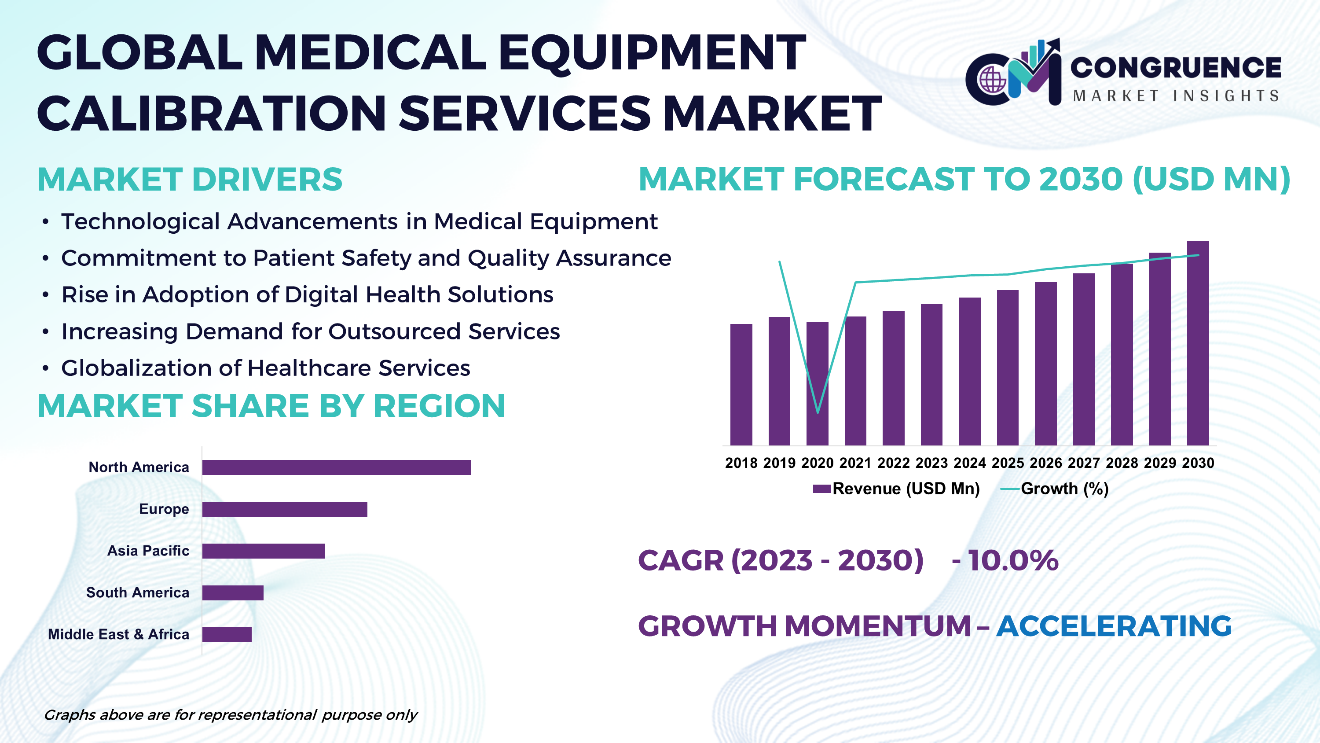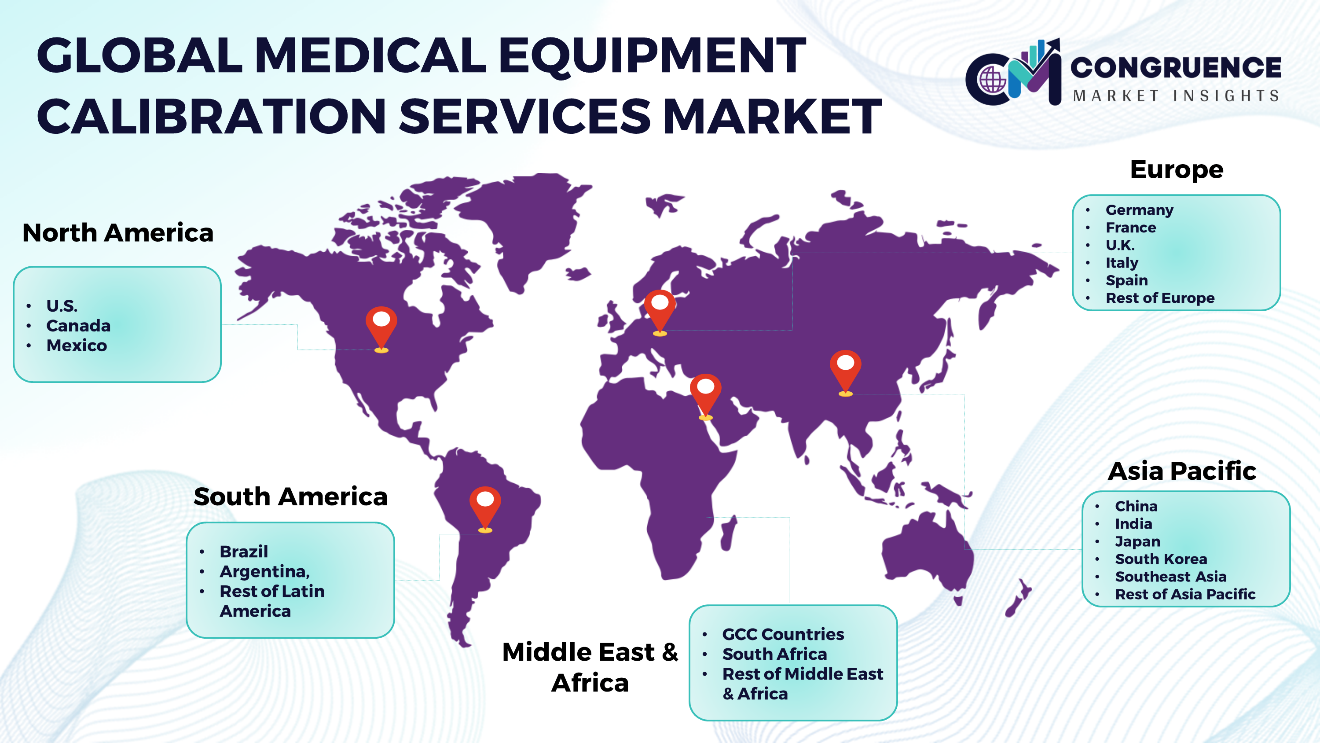Reports
The Global Medical Equipment Calibration Services Market is expected to expand at a CAGR of 10% between 2023 and 2030. Medical equipment calibration services are essential for maintaining the accuracy and reliability of healthcare devices, thereby ensuring patient safety. Technological advancements, such as automated processes and cloud-based management systems, have significantly improved precision and operational efficiency within this sector. The integration of digital health solutions is instrumental in providing real-time tracking, proactive maintenance, and adherence to regulatory standards. The market for these services is experiencing steady growth due to increasing regulatory requirements and the escalating demand for quality healthcare services. Major industry players offer tailored solutions for hospitals, diagnostic laboratories, and research institutions. Additionally, there is a noticeable trend towards outsourcing calibration services to specialized providers, fostering innovation in service delivery models and ultimately enhancing equipment performance and patient outcomes.

Medical Equipment Calibration Services Market Major Driving Forces
Technological Advancements in Medical Equipment: Ongoing technological progress in medical devices and equipment demands increasingly precise calibration techniques to uphold accuracy and reliability. The complexity of modern medical equipment creates opportunities for calibration service providers to deliver specialized solutions tailored to these advancements.
Commitment to Patient Safety and Quality Assurance: Healthcare institutions prioritize patient safety and the assurance of quality care, underlining the critical role of accurate calibration in medical equipment. Calibration services mitigate risks associated with inaccurate measurements or equipment malfunctions, thereby elevating patient outcomes.
Rise in Adoption of Digital Health Solutions: The integration of digital health solutions, such as IoT-enabled devices and cloud-based calibration management systems, optimizes calibration processes and enables real-time equipment monitoring. This trend enhances operational efficiency and minimizes downtime across healthcare facilities.
Increasing Demand for Outsourced Services: Healthcare entities, especially smaller clinics and laboratories, are increasingly turning to specialized providers for calibration services. Outsourcing offers access to expertise, advanced technologies, and cost-effective solutions, eliminating the need for in-house calibration infrastructure.
Globalization of Healthcare Services: The globalization of healthcare, alongside the expansion of medical tourism, opens avenues for calibration service providers to cater to a wider market. Compliance with international standards and accreditation further stimulates demand for calibration services on a global scale.
Medical Equipment Calibration Services Market Key Opportunities
Technological Integration: Incorporating advanced technologies such as IoT, artificial intelligence, and machine learning into calibration processes offers avenues for improved automation, real-time monitoring, and predictive maintenance. Providers can utilize these technologies to enhance operational efficiency and minimize downtime.
Specialized Calibration Services: With the increasing complexity and specialization of medical equipment, there is a growing demand for tailored calibration solutions. Providers can capitalize on this demand by offering specialized calibration services designed for specific devices and applications.
Remote Calibration Services: The adoption of digital health solutions has led to a rising trend in remote calibration services. Providers can capitalize on this trend by leveraging telemedicine platforms and IoT-enabled devices to offer remote calibration services, meeting the needs of geographically dispersed healthcare facilities.
Compliance Consulting Services: Healthcare organizations face intricate regulatory requirements related to equipment calibration. Providers can offer compliance consulting services to assist healthcare facilities in navigating regulatory landscapes, ensuring adherence to standards, and mitigating compliance risks.
Medical Equipment Calibration Services Market Key Trends
· Technological advancements like automation, IoT, and AI, improving efficiency and accuracy.
· A shift to digital calibration management systems for real-time tracking and compliance.
· Emphasis on preventive maintenance strategies to minimize downtime.
· Increasing outsourcing to specialized providers for expertise and compliance assurance.
· Adherence to regulatory standards through accreditation and certification.
· Growing demand for niche calibration services tailored to specific devices.
· Integration with telehealth for remote monitoring and maintenance.
· Adoption of eco-friendly practices and equipment for sustainability.

Market Competition Landscape
In the domain of medical equipment calibration services, the competitive landscape is characterized by robust competition among providers. They strive to differentiate themselves through technological innovation, service excellence, and client satisfaction. As regulatory demands intensify and customer expectations evolve, companies prioritize the provision of comprehensive solutions, value-added services, and strategic partnerships. These endeavors are aimed at securing a competitive edge and augmenting market presence.
Key players in the global Medical Equipment Calibration Services market implement various organic and inorganic strategies to strengthen and improve their market positioning. Prominent players in the market include:
· Agilent
· Danaher
· Keysight Technologies
· Fluke
· Tektronix, Inc.
· Bio-Techne
· Thermo Fisher Scientific Inc.
· GE HealthCare
· Siemens Healthcare Private Limited
· ZEISS
· Rigaku Corporation
· PerkinElmer Inc.
· Shimadzu Corporation
· Hitachi, Ltd.
· Bruker
· Stryker
· Hologic, Inc.
· Criticam Medical Systems LLP
|
Report Attribute/Metric |
Details |
|
Base Year |
2022 |
|
Forecast Period |
2023 – 2030 |
|
Historical Data |
2018 to 2022 |
|
Forecast Unit |
Value (US$ Mn) |
|
Key Report Deliverable |
Revenue Forecast, Growth Trends, Market Dynamics, Segmental Overview, Regional and Country-wise Analysis, Competition Landscape |
|
Segments Covered |
· By Service Type (In-House, and Outsourced) · By Equipment Type (Patient Monitoring Devices, Imaging Equipment, Surgical Instrument, Therapeutic Equipment, and Others) · By End User (Hospitals and Clinics, Diagnostic Centers and Laboratories, Ambulatory Surgical Centers (ASCs), and Others) · By Sales Channel (Independent Small Stores, Specialty Stores, Online Retailing, and Others) |
|
Geographies Covered |
North America: U.S., Canada and Mexico Europe: Germany, France, U.K., Italy, Spain, and Rest of Europe Asia Pacific: China, India, Japan, South Korea, Southeast Asia, and Rest of Asia Pacific South America: Brazil, Argentina, and Rest of Latin America Middle East & Africa: GCC Countries, South Africa, and Rest of Middle East & Africa |
|
Key Players Analyzed |
Agilent, Danaher, Keysight Technologies, Fluke, Tektronix, Inc., Bio-Techne, Thermo Fisher Scientific Inc., GE HealthCare, Siemens Healthcare Private Limited, ZEISS, Rigaku Corporation, PerkinElmer Inc., Shimadzu Corporation, Hitachi, Ltd., Bruker, Stryker, Hologic, Inc., Criticam Medical Systems LLP |
|
Customization & Pricing |
Available on Request (10% Customization is Free) |
